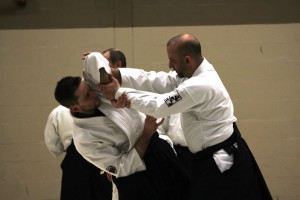How does Aikido differ from other arts?
 Traditional Aikido is non-competitive and promotions do not come through besting an opponent, but through demonstrating understanding of basic exercises and techniques, which become more demanding or difficult as rank increases.
Traditional Aikido is non-competitive and promotions do not come through besting an opponent, but through demonstrating understanding of basic exercises and techniques, which become more demanding or difficult as rank increases.
In Aikido we strive to work in cooperation with a partner, still employing effective technique against an energetic and realistic attack, yet doing so by blending with the attack and redirecting its energy back to the attacker. We practice techniques against a variety of attacks such as kicks, punches, strikes, single-hand or two-hand grabs from the front or rear, chokes, multiple person attacks, and attacks with weapons. In all of these we strive to resolve the conflict in a non-lethal, non-disruptive, yet effective manner. Techniques may end in joint locks or immobilizations, or in dynamic motions where the attacker is thrown forwards or backwards across the mat, or through the air into a spectacular breakfall. Rather than primarily linear motions, Aikido is comprised of blending, turning, pivoting, circling, and spiraling. We are learning to deal not only with our own energy, but with that of an attacker or another person (or people) as well. Aikido embodies concepts which are at the same time very simple, yet very complex. Because of these and other differences, Aikido can be very challenging to learn, yet at the same time can be very rewarding because it is ultimately bringing us into harmony with ourselves and with our world, and helping us to become more complete and integrated human beings.

